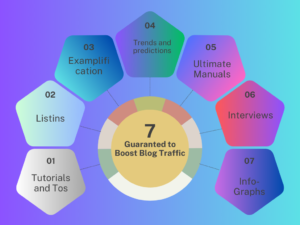In today’s digital landscape, achieving a high ranking on search engine result pages (SERPs) is crucial for any website aiming to attract organic traffic. On-page SEO, which involves optimizing individual web pages to improve their visibility and ranking, plays a vital role in this process. This comprehensive guide will delve into the best on-page SEO techniques, offering detailed insights and actionable strategies to help you elevate your website’s performance.

Highlighted Action Points to Remember
- Introduction to One-Page SEO
- Keyword Optimization
- Importance of Keyword Research
- Effective Keyword Placement
- Creating High-Quality Content
- Aligning Content with User Intent
- Structuring and Formatting Content
- Optimizing Meta Tags
- Crafting Compelling Meta Titles
- Writing Effective Meta Descriptions
- URL Optimization
- Best Practices for URL Structure
- Avoiding Common URL Mistakes
- Utilizing Header Tags
- Hierarchical Use of Header Tags
- Enhancing Content Readability
- Image Optimization
- Optimizing File Names and Alt Tags
- Reducing Image File Sizes
- Internal Linking Strategies
- Benefits of Internal Linking
- Best Practices for Internal Links
- Mobile Optimization
- Importance of Mobile-Friendly Design
- Techniques for Responsive Web Design
- Improving Page Loading Speed
- Techniques to Enhance Speed
- Tools for Measuring Page Speed
- Implementing Schema Markup
- Benefits of Structured Data
- Types of Schema Markup
- Integrating Social Sharing Features
- Encouraging Content Sharing
- Implementing Social Media Buttons
- Enhancing User Experience
- Importance of User Experience in SEO
- Strategies for Better Site Navigation
- Monitoring and Updating Your SEO Strategy
- Tools for SEO Monitoring
- Keeping Up with SEO Trends
- Conclusion: The Future of On-Page SEO
1. Introduction to On-Page SEO
On-page SEO is the practice of optimizing individual web pages to rank higher in search engines and attract more relevant traffic. This process involves making various adjustments to both the content and HTML source code of a page. Unlike off-page SEO, which focuses on external signals like backlinks, on-page SEO gives you complete control over the elements you can directly influence. This guide will cover everything you need to know to master on-page SEO.
2. Keyword Optimization
Importance of Keyword Research
Keyword research is the foundation of any successful SEO strategy. It involves identifying the search terms and phrases that potential visitors use to find content related to your website. Tools like Google Keyword Planner, Ahrefs, and SEMrush can help you discover high-volume, low-competition keywords.
Effective Keyword Placement
Once you’ve identified the right keywords, strategically place them in the following areas:
- Title Tags: Ensure your primary keyword appears near the beginning of the title.
- Headings (H1, H2, H3, etc.): Use keywords in headings to signal the relevance of your content.
- Meta Descriptions: Include primary and secondary keywords to improve click-through rates.
- URL: Create keyword-rich URLs that are concise and descriptive.
- Content: Integrate keywords naturally throughout your content, avoiding keyword stuffing.
- Image Alt Text: Use descriptive keywords in image alt attributes to enhance SEO and accessibility.

3. Creating High-Quality Content
Aligning Content with User Intent
Creating content that aligns with user intent is critical for on-page SEO. User intent refers to the reason behind a user’s search query. By understanding and addressing this intent, you can create content that satisfies users and search engines alike. Content should be informative, engaging, and provide value to the reader.
Structuring and Formatting Content
Properly structured content is easier for search engines to crawl and for users to read. Use the following techniques to enhance your content structure:
- Headings and Subheadings: Organize your content with clear headings and subheadings.
- Short Paragraphs: Break content into short, digestible paragraphs.
- Bullet Points and Lists: Use bullet points and lists to present information clearly.
- Multimedia: Incorporate images, videos, and infographics to enrich the content and improve engagement.
- Internal and External Links: Include relevant links to provide additional context and resources.
4. Optimizing Meta Tags
Crafting Compelling Meta Titles
Meta titles are one of the most important on-page SEO elements. They should accurately reflect the content of the page while being enticing to users. Best practices include:
- Length: Keep meta titles under 60 characters.
- Keywords: Place primary keywords near the beginning.
- Uniqueness: Ensure each meta title is unique across your site.
- Clarity: Make titles clear and descriptive.
Writing Effective Meta Descriptions
Meta descriptions provide a summary of the page content and appear below the meta title in search results. While not a direct ranking factor, well-crafted meta descriptions can improve click-through rates. Tips for writing meta descriptions include:
- Length: Keep descriptions under 160 characters.
- Keywords: Incorporate primary and secondary keywords naturally.
- Call to Action: Include a compelling call to action to encourage clicks.
- Relevance: Ensure the description accurately reflects the page content.
5. URL Optimization
Best Practices for URL Structure
Optimizing your URLs makes it easier for both users and search engines to understand the content of your pages. Follow these best practices:
- Simplicity: Keep URLs short and simple.
- Keywords: Include relevant keywords to describe the content.
- Hyphens: Use hyphens to separate words for better readability.
- Avoid Numbers and Symbols: Steer clear of long strings of numbers and symbols.
Avoiding Common URL Mistakes
Avoid these common URL mistakes to ensure better SEO performance:
- Dynamic URLs: Replace dynamic URLs with static, keyword-rich URLs.
- Capital Letters: Avoid using capital letters, as URLs are case-sensitive and can lead to duplicate content issues.
- Keyword Stuffing: Don’t overuse keywords in URLs; keep them concise and relevant.
6. Utilizing Header Tags
Hierarchical Use of Header Tags
Header tags (H1, H2, H3, etc.) help organize your content and signal its hierarchy to search engines. Proper use of header tags improves readability and SEO:
- H1 Tag: Use a single H1 tag for the main title of the page.
- H2 Tags: Use H2 tags for major sections.
- H3 and H4 Tags: Use H3 and H4 tags for subsections and detailed points.
Enhancing Content Readability
Well-structured header tags not only benefit SEO but also enhance the user experience. They make content easier to scan, which is especially important for mobile users. Ensure each header accurately reflects the section’s content to improve both readability and relevance.

7. Image Optimization
Optimizing File Names and Alt Tags
Images can significantly enhance the appeal of your content but also impact SEO. Properly optimizing images ensures they contribute positively to your site’s performance:
- File Names: Use descriptive, keyword-rich file names for images.
- Alt Tags: Include relevant keywords in alt tags to describe the image. This improves accessibility and helps search engines understand the image content.
Reducing Image File Sizes
Large image files can slow down your website, negatively affecting user experience and SEO. Techniques for reducing image file sizes include:
- Compression: Use tools like TinyPNG or JPEG Optimizer to compress images without losing quality.
- Proper Formats: Use appropriate formats (JPEG for photographs, PNG for graphics with transparency).
- Responsive Images: Use responsive image techniques to deliver appropriately sized images for different devices.
8. Internal Linking Strategies
Benefits of Internal Linking
Internal linking involves linking to other pages within your website. This practice has several SEO benefits:
- Improves Navigation: Helps users find related content easily.
- Distributes Page Authority: Spreads link equity across your site.
- Enhances Crawling: Helps search engines discover and index more pages.
Best Practices for Internal Links
To make the most of internal linking, follow these best practices:
- Relevant Links: Link to relevant pages that provide additional value.
- Anchor Text: Use descriptive anchor text that includes keywords.
- Limit Links: Avoid excessive linking; focus on quality and relevance.
- Hierarchy and Structure: Link from high-authority pages to lower-authority pages to distribute link equity effectively.
9. Mobile Optimization
Importance of Mobile-Friendly Design
With the increasing use of mobile devices, having a mobile-friendly website is essential. Google uses mobile-first indexing, meaning it predominantly uses the mobile version of the content for indexing and ranking. A mobile-optimized site improves user experience and SEO.
Techniques for Responsive Web Design
Implement these techniques to ensure your site is mobile-friendly:
- Responsive Design: Use responsive design techniques to ensure your site adapts to different screen sizes.
- Mobile-Friendly Navigation: Simplify navigation for mobile users with clear menus and touch-friendly buttons.
- Fast Loading Times: Optimize images and use accelerated mobile pages (AMP) to improve loading speed on mobile devices.
10. Improving Page Loading Speed
Techniques to Enhance Speed
Page loading speed is a critical factor for both user experience and SEO. Here are some techniques to enhance your site’s speed:
- Minimize Code: Reduce the size of HTML, CSS, and JavaScript files.
- Browser Caching: Leverage browser caching to store static files locally on users’ devices.
- Content Delivery Network (CDN): Use a CDN to deliver content from servers closer to the user’s location.
- Image Optimization: Compress images and use appropriate formats to reduce file size.
Tools for Measuring Page Speed
Use these tools to measure and improve your page speed:
- Google PageSpeed Insights: Provides suggestions for improving page speed.
- GTmetrix: Offers detailed insights and recommendations.
- Pingdom: Measures site performance and provides actionable tips.

11. Implementing Schema Markup
Benefits of Structured Data
Schema markup, or structured data, helps search engines understand the content of your pages and provide richer search results. Benefits include:
- Enhanced Visibility: Rich snippets can increase click-through rates.
- Better Understanding: Helps search engines understand the context of your content.
- Improved Rankings: While not a direct ranking factor, enhanced visibility can indirectly improve rankings.
Types of Schema Markup
Implement these types of schema markup to improve your SEO:
- Article Schema: For news articles and blog posts.
- Product Schema: For e-commerce product listings.
- Review Schema: For customer reviews and ratings.
- Event Schema: For events with dates, locations, and other details.
- FAQ Schema: For frequently asked questions and answers.
12. Integrating Social Sharing Features
Encouraging Content Sharing
Social sharing can increase the visibility of your content and drive more traffic to your site. Encourage sharing by:
- Including Social Buttons: Add social sharing buttons to blog posts and key pages.
- Creating Shareable Content: Develop engaging and share-worthy content.
- Promoting Content: Actively promote your content on social media platforms.
Implementing Social Media Buttons
Proper implementation of social media buttons can enhance user experience and SEO:
- Visible Placement: Place buttons where they are easily accessible, such as at the beginning or end of posts.
- Responsive Design: Ensure buttons are mobile-friendly.
- Tracking: Use UTM parameters to track the performance of social shares.
13. Enhancing User Experience
Importance of User Experience in SEO
A positive user experience is crucial for retaining visitors and improving SEO. Search engines favor sites that offer a good user experience, which is reflected in lower bounce rates and higher engagement.
Strategies for Better Site Navigation
Enhance user experience with these strategies:
- Clear Navigation: Use intuitive and straightforward menus.
- Consistent Layout: Maintain a consistent design across all pages.
- Readability: Use legible fonts and appropriate font sizes.
- Accessibility: Ensure your site is accessible to all users, including those with disabilities.
14. Monitoring and Updating Your SEO Strategy
Tools for SEO Monitoring
Regularly monitoring your SEO performance is essential to identify areas for improvement. Use these tools:
- Google Analytics: Track website traffic and user behavior.
- Google Search Console: Monitor search performance and fix issues.
- Ahrefs/Semrush: Analyze backlinks, track keyword rankings, and perform site audits.
Keeping Up with SEO Trends
SEO is constantly evolving, so it’s important to stay updated with the latest trends and best practices:
- Follow Industry Blogs: Read blogs like Moz, Search Engine Journal, and Neil Patel.
- Attend Webinars and Conferences: Participate in SEO webinars and conferences to learn from experts.
- Regular Audits: Conduct regular SEO audits to ensure your site adheres to current best practices.

15. Conclusion: The Future of On-Page SEO
On-page SEO will continue to be a vital component of any successful digital marketing strategy. As search engines evolve and user behavior changes, staying ahead of the curve requires a commitment to continuous learning and adaptation. By implementing the techniques outlined in this guide and regularly updating your strategy, you can ensure your website remains competitive in search engine rankings and continues to attract organic traffic.
Conclusion Synthesis
This comprehensive guide on on-page SEO provides detailed strategies and best practices to help you optimize your website effectively. By focusing on keyword optimization, high-quality content, meta tag optimization, URL structure, header tags, image optimization, internal linking, mobile optimization, page speed, schema markup, social sharing, user experience, and regular monitoring, you can significantly improve your website’s search engine performance and user engagement.
FAQs on On-Page SEO Techniques
What is on-page SEO?
On-page SEO refers to the practice of optimizing individual web pages to improve their search engine rankings and drive organic traffic. This involves adjusting various elements on the page, such as content, meta tags, URL structure, and internal links, to make the page more attractive to search engines and users.
Why is keyword optimization important in on-page SEO?
Keyword optimization is crucial because it helps search engines understand the content and relevance of your web pages. By conducting thorough keyword research and strategically placing relevant keywords in titles, headings, meta tags, URLs, and content, you can improve your page’s visibility and ranking for those search terms.
How can I create high-quality content for SEO?
Creating high-quality content involves:
- Understanding and aligning with user intent.
- Structuring content with clear headings, subheadings, bullet points, and short paragraphs.
- Incorporating multimedia like images and videos.
- Using internal and external links for additional context.
- Ensuring the content is unique, engaging, and provides value to the reader.
What are meta tags, and why should I optimize them?
Meta tags are snippets of text that describe a page’s content; they don’t appear on the page itself but in the page’s source code. Key meta tags include the meta title and meta description. Optimizing meta tags is important because they help search engines understand your page’s content and entice users to click on your link in search results.
What are the best practices for URL optimization?
Best practices for URL optimization include:
- Keeping URLs short and simple.
- Including relevant keywords.
- Using hyphens to separate words.
- Avoiding numbers and symbols.
- Creating descriptive and readable URLs that reflect the page content.
How should I use header tags in my content?
Header tags (H1, H2, H3, etc.) should be used hierarchically to organize your content:
- Use one H1 tag for the main title.
- Use H2 tags for major sections.
Use H3 and lower-level tags for subsections.
- This structure improves readability and helps search engines understand the content hierarchy.
Why is image optimization important for SEO?
Image optimization improves page load speed, enhances user experience, and helps search engines understand the content of your images. Optimize images by using descriptive file names and alt tags, compressing image files to reduce size, and choosing the appropriate image formats.
What are the benefits of internal linking?
Internal linking helps users navigate your site, distributes page authority across your site, and aids search engines in crawling and indexing your pages. It also helps establish a clear site structure and can improve user engagement by guiding them to related content.
How can I ensure my website is mobile-friendly?
To ensure your website is mobile-friendly:
- Use responsive design techniques to adapt to different screen sizes.
- Simplify navigation for mobile users with clear menus and touch-friendly buttons.
- Optimize images and use accelerated mobile pages (AMP) to improve loading speed on mobile devices.
What techniques can I use to improve page loading speed?
To improve page loading speed:
- Minimize HTML, CSS, and JavaScript code.
- Enable browser caching to store static files locally on users’ devices.
- Use a content delivery network (CDN) to deliver content from servers closer to the user’s location.
- Compress images and use appropriate formats to reduce file sizes.
What is schema markup, and how does it benefit SEO?
Schema markup, or structured data, is code that you add to your website to help search engines understand the content of your pages. It can result in rich snippets in search results, enhancing visibility and click-through rates. Types of schema markup include articles, products, reviews, events, and FAQs.
How can I encourage users to share my content on social media?
Encourage social sharing by:
- Including social sharing buttons on your pages.
- Creating engaging and share-worthy content.
- Actively promoting your content on social media platforms.
- Ensuring social sharing buttons are mobile-friendly and easy to use.
How does user experience affect SEO?
A positive user experience leads to higher engagement, lower bounce rates, and better retention, which are signals that search engines consider when ranking pages. Improve user experience by having a clear navigation structure, consistent layout, readable fonts, and ensuring accessibility for all users.
What tools can I use to monitor my SEO performance?
Tools for monitoring SEO performance include:
- Google Analytics: Tracks website traffic and user behavior.
- Google Search Console: Monitors search performance and identifies issues.
- Ahrefs/Semrush: Analyzes backlinks, tracks keyword rankings, and performs site audits.
How can I keep up with the latest SEO trends?
Stay updated with SEO trends by:
- Following industry blogs like Moz, Search Engine Journal, and Neil Patel.
- Attending webinars and conferences.
- Conducting regular SEO audits to ensure your site follows current best practices.
- Engaging with SEO communities and forums.






Hello! I just wanted to say how much I appreciated this blog post. Your writing is always so engaging and informative. It’s clear that you have a deep understanding of the subject matter. Thank you for sharing your expertise with us. Looking forward to your next post!
Hi! I just finished reading your blog post, and I must say, it was excellent. Your ability to explain complicated concepts in a simple and engaging way is truly remarkable. Thank you for providing such valuable content. I can’t wait to read more from you in the future.
Hi there! I must say, this blog post really caught my attention. Your writing style is so captivating, and the way you presented the information made it easy to understand and enjoyable to read. Thank you for sharing your expertise on this topic. I’m eager to see what you write about next.
Hi! I just finished reading your blog post, and I must say, it was excellent. Your ability to explain complicated concepts in a simple and engaging way is truly remarkable. Thank you for providing such valuable content. I can’t wait to read more from you in the future.
Hello! I wanted to drop by and say that I really enjoyed this blog post. Your writing is always so clear and concise, and you have a talent for making complex topics easy to understand. Thank you for sharing your insights with us. I’m looking forward to your next post!
Hi there! Just wanted to let you know how much I enjoyed reading this post. Your approach to the subject was unique and informative. It’s clear that you put a lot of effort into your writing. Keep up the great work, and I can’t wait to see what else you have in store.
This was an amazing read! Your insights on this topic are very valuable and have given me a lot to think about. I appreciate the time and effort you put into researching and writing this post. Thank you for sharing your knowledge with us.
Great post! I enjoyed reading it and learned a lot. Your writing style is engaging and easy to follow, and the information you provided was very helpful. Thank you for sharing your knowledge and expertise on this topic. Keep up the good work.
Hello! I wanted to drop by and say that I really enjoyed this blog post. Your writing is always so clear and concise, and you have a talent for making complex topics easy to understand. Thank you for sharing your insights with us. I’m looking forward to your next post!
Hey there! I wanted to take a moment to let you know how much I enjoyed this blog post. Your insights were incredibly helpful and thought-provoking. It’s clear that you put a lot of effort into your writing. Thank you for sharing your expertise with us. Looking forward to your next post!
Thank you for this wonderful post! I found it very informative and engaging. Your thorough research and clear writing style made it easy to understand. I appreciate the time and effort you put into creating this valuable content. Keep up the excellent work.
Hi there! Just wanted to let you know how much I enjoyed reading this post. Your approach to the subject was unique and informative. It’s clear that you put a lot of effort into your writing. Keep up the great work, and I can’t wait to see what else you have in store.
Fantastic job breaking down this topic, like a demolition crew for my misconceptions.
The research depth is so evident, I almost thought this was a thesis defense.
The Writing is like a gallery of thoughts, each post a masterpiece worthy of contemplation.
I’m always excited to see The posts in my feed. Another excellent article!
A masterpiece of writing—you’ve covered all bases with such finesse, I’m left wanting an encore.
The attention to detail is remarkable, like a detective at a crime scene, but for words.
The posts inspire me regularly. The depth you bring to The topics is truly exceptional.
Greetings! I found this blog post to be incredibly informative and well-written. Your ability to break down complex topics into easy-to-understand language is truly a gift. Thank you for sharing your knowledge with us. I’m excited to read more of your posts in the future!
Greetings! I just wanted to let you know how much I appreciated this blog post. Your writing is always so engaging and informative. It’s clear that you have a deep understanding of the subject matter. Thank you for sharing your expertise with us. Looking forward to your next post!
Thank you for this insightful post! The information you provided is very useful and well-explained. I especially liked how you broke down complex concepts into easily understandable parts. Your writing is clear and concise, making it a pleasure to read. Keep up the great work.
Hi! I just finished reading your blog post, and I must say, it was excellent. Your ability to explain complicated concepts in a simple and engaging way is truly remarkable. Thank you for providing such valuable content. I can’t wait to read more from you in the future.
Hi there! Just wanted to let you know how much I enjoyed reading this post. Your approach to the subject was unique and informative. It’s clear that you put a lot of effort into your writing. Keep up the great work, and I can’t wait to see what else you have in store.
Great article! I learned so much from it. Your in-depth analysis and thoughtful insights were very helpful. I appreciate the effort you put into writing this and sharing it with us. Thank you for your hard work and dedication to providing valuable content.
Greetings! I found this blog post to be incredibly informative and well-written. Your ability to break down complex topics into easy-to-understand language is truly a gift. Thank you for sharing your knowledge with us. I’m excited to read more of your posts in the future!
You’ve opened my eyes to new perspectives, as if you knew the way to my curious heart.
I must admit, The depth of analysis is as attractive as The words. Great work has never looked so good.
The take on hard to understand topics is like a smooth ride in a luxury car—comfortable, yet exhilarating.
The information you’ve shared has been a revelation for me. Incredibly enlightening!
The blend of informative and entertaining content is perfect. I enjoyed every word.
The depth of The research is impressive, almost as much as the way you make hard to understand topics captivating.
The work is truly inspirational. I appreciate the depth you bring to The topics.
The work is both informative and thought-provoking. I’m really impressed by the high quality of The content.
The analysis is like a well-crafted movie—engaging, enlightening, and leaving me thinking long after it’s over.
I’m bookmarking this for future reference. The advice is spot on!
This post is a testament to The expertise and hard work. Thank you!
A breath of fresh air, or what I needed after being suffocated by mediocrity.
The Writing is a constant source of inspiration and knowledge, like a muse that never fails to inspire. Thank you for being my muse.
Adding value to the conversation, because what’s a discussion without The two cents?
I’m amazed by The knowledge, almost as much as I’m drawn to the way you present it. Share more, please?